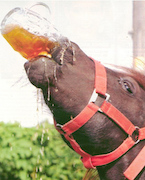|
Kraftwerk posted:Can you clean your equipment within dish soap? I thought Iíd give everything an initial cleanse with Dawn before I use my star San. Just to wash off any traces of stuff left from manufacturing. Yeah, just make sure you rinse it really well so it doesn't taste like soap. The homebrewer approved favorite cleanser is Powdered Brewery Wash (PBW), but you can also use OxiClean Free (don't use anything with fragrance)
|
|
|
|

|
| # ? Jun 10, 2024 19:31 |
|
more falafel please posted:Yeah, just make sure you rinse it really well so it doesn't taste like soap. The homebrewer approved favorite cleanser is Powdered Brewery Wash (PBW), but you can also use OxiClean Free (don't use anything with fragrance) I have easy clean by LD Carlson. https://storefront.ldcarlson.com/st...em-number=6019B A small bag of it came with my stuff. Should I use this instead?
|
|
|
more falafel please posted:I'm not a big fan of pickles usually, but my brew club's resident "weird beer guy" has made pickle beer before. It wasn't as bad as "salsa beer". The 2019 Homebrew Con, I had pizza beer. It tasted like pizza, I couldn't drink more than an ounce or two of it.
|
|
|
|
|
calandryll posted:The 2019 Homebrew Con, I had pizza beer. It tasted like pizza, I couldn't drink more than an ounce or two of it. The best pizza beer is the one you're drinking with pizza.
|
|
|
|
Kraftwerk posted:I have easy clean by LD Carlson. Yeah thatís a better choice than dawn for brewing. Also, donít run bottles through the dishwasher with the drying agent on. Itís bad for head retention. The aforementioned PBW or OxyClean Free are also top tier cleaners for brewing.
|
|
|
|
the best burger beer is low-abv hoppy saisons
|
|
|
|
Hot water helps on the rinse, just hot as is comfortable to work with. Don't use anything that will scratch stuff. Scratches give bacteria a place to hide. Soft side of the sponge or a rag is fine. Dish soap is fine if you rinse well, +1 for pbw/oxiclean free being great. Also really good for removing labels if you let it soak overnight.
|
|
|
|
Kraftwerk posted:Can you clean your equipment within dish soap? I thought Iíd give everything an initial cleanse with Dawn before I use my star San. Just to wash off any traces of stuff left from manufacturing. I use unscented dish soap for my first cleaning to get the tough bits of krausen off my Ale Pails or the schmutz off the side of the kettle. I hear scented soap can really stick to plastics or other surfaces, so I just don't keep any in the house anymore (because who wants it anyway). Then I rinse a lot and typically sanitize before letting things dry out. I always start off my brew by making a big bucket of sanitizer in what will eventually be the fermentation bucket. I'm pretty diligent about cleaning an sanitizing, and have yet to have an infection after years (and years of using the same equipment), using plastic bottling buckets this whole time because I can't live without a spigot. Unrelated, I recently built out a 4-keg, 1 fermenter keezer that I am really proud of, upgrading from a free kegerator that kicked the bucket. I absolutely love having the flexibility and variety of having multiple beers on tap. It also helps keep the hobby somewhat compact in an NYC apartment. I recently upgraded to all EVABarrier + Duotight fittings for everything on the keezer and it is incredible. No more chewing off knuckles trying to get vinyl on flares, no more weird tasting vinyl flavors after sanitizing the lines. Highly recommend it. Also, picked up a HotRod Heatstick from BrewHardware. Total lifesaver for the apartment range taking forever on all-grain boils. My next plans are going to be to wrap a fermenter with a heater and sew a neoprene jacket over it so I can lager in the keezer with the 4 beers at serving temperature. The dream. Also start working out again because beer.
|
|
|
|
How far should I fill the fermenter before inserting stuff like my auto siphon etc. Thereís at least 2 more gallons past the 5 gallon mark that can serve as empty space. The lid also needs to be sanitized too I imagine and wonít fit into the pail sideways. Also what is the exact process for using the cleaner so far Iíve poured 2-3 gallons of water in. Mixed a tablespoon per gallon and shook it around a bit before pouring it out and giving it a second rinse. I did the same with the carboy which Iíll use as a secondary fermenter. When I use my auto siphon to move the wort from the kettle to the fermenter and then the fermenter to the secondary, should I also transmit any solid matter with it? Or should I try to avoid the solid matter? This will also be relevant when I start bottling.
|
|
|
|
Kraftwerk posted:How far should I fill the fermenter before inserting stuff like my auto siphon etc. Thereís at least 2 more gallons past the 5 gallon mark that can serve as empty space. The lid also needs to be sanitized too I imagine and wonít fit into the pail sideways. I have a 6.5 gal pail that I fill to 5-gallons every batch. You want a good bit of room for the karusen so it doesn't clog up your airlock. 1.5 gallons has always worked for me, but a gallon should be enough room in a bucket. I used to jam the lid in sideways, but now I keep a spray bottle of sanitizer around. The any-angle ones from McMaster are great and cheap. Just spray some on, after you've cleaned the lid, and let it sit for at least 30-sec, or a few minutes. Cleaning/sanitizing: Dump, but don't rinse if using Star San, it's just phosphoric acid (flavor neutral, and very diluted at this point) and a foaming agent so it gets on all surfaces. I use phosphoric acid to control my mash pH, it's exceptionally safe (and necessary) in no-rinse volumes. If using PBW / OxyClean, the directions usually say to let it sit for 20-25 minutes between 100F-150F (38-65C), and rinse thoroughly with the same temperature water before sanitizing. It's important to rinse it hot so it doesn't leave film behind. I have no idea how long its safe on plastic, but the label says its fine. I've always just used unscented soap on my buckets, but I tend to always follow the directions on the wacky chemicals (and use gloves). If its your first batch, a light cleaning, thorough rinse + normal sanitizing should be totally fine. Don't worry too much about siphoning solid matter from the kettle. My kettle has a bottom that collects it so it doesn't end up in the fermenter, which maybe helps with chill haze, maybe not. It will not impact the flavor. I have never done a secondary, as it's an endless argument whether anyone can ever actually tell a difference. There is definitely enough yeast in suspension for the secondary stage without getting any trub, and in fact, the idea is to remove it off the trub. There's also plenty of yeast in suspension for bottle conditioning without stirring anything up. The biggest risk of racking to a secondary is splashing the beer and oxidizing the finished beer, which is a big no-no after fermentation. It makes the beer taste papery at best, skunked at worst. Personally, I don't know anyone who does a secondary, as nobody I brew with seems to think that it's worth the risk of oxidation. But, some people swear by it! I am not a professional brewer, but the rumor is racking to a secondary got cargo culted to homebrewing from a professional procedure that is trying to avoid issues with the large hydrostatic pressure on trub in professional breweries, as well as trying to free up space for another primary. I've left even the hoppiest of beers on trub for as long as a month, and they've come out excellent. I'm interested to hear how it works out for you. Edit: Make sure when you're siphoning from your kettle to the fermenter to oxidize the chilled wort. I used to do this by pouring it back and forth from the kettle, to the fermenter. Now I just pour it through a big, mesh strainer. Yeast needs oxygen to build up the initial population. Rectovagitron fucked around with this message at 04:23 on Jan 16, 2021 |
|
|
|
Rectovagitron posted:Edit: Make sure when you're siphoning from your kettle to the fermenter to oxidize the chilled wort. I used to do this by pouring it back and forth from the kettle, to the fermenter. Now I just pour it through a big, mesh strainer. Yeast needs oxygen to build up the initial population. Oxygenate!  Oxidizing is bad.
|
|
|
|
I use a secondary sometimes - I think it's really useful if you're making a beer with extra stuff in primary like dry hopping or a fruit addition, or even just beers that have really big krausen or you want a very clear finish. I'm sure it's possible to avoid getting crap like that in your bottles, but when I siphon straight from primary I always end up with some of that stuff floating about, whereas a few weeks in secondary generally gives me a much cleaner beer. Might also be a holdover for me from winemaking, which I did before starting with beers, where you rack a number of times and don't bottle until your product is absolutely crystal clear and there are no lees visible at the bottom of your vessel. I don't do it with every beer, though. Something like a weiŖbier where the style is young, yeasty and hazy it would probably harm the finished beer even leaving oxidisation aside.
|
|
|
|
My flanders red with blueberries is past its earthy phase and is now real funky and nice, but it never soured. I still have the yeast culture banked though, and I will be blending it with my saison culture that sours real nice. It's certainly drinkable, although I miss the brightness, the main issue is that either the dip tube is clogged or pectin and fruit gunk clogs the taps. Playing with the flow control sometimes gets it to a slow trickle... I am at a loss. Maybe I will chill and carb it and see if it flows better.
|
|
|
|
I secondaried my mix yeast easter braggot from last year just cause it ended up being seriously high gravity, and it really helped clear it up a bit. I wouldn't do it to most beers, but if you're doing anything funky it might definitely come into play. Bit of time has passed now and I can say with absolute certainty that my graff experiment failed badly. It's tart, bitter and disgusting. I don't know if it's just that I really shouldn't have followed the recipe and used US-05 of what was primarily a cider, but instead definitely used a cider yeast or if it's just my stupid loving fermentation chamber that just won't play well with my small conical fermentor. I'm still really struggling with it because the conical fermentor keeps a lot of the liquid fairly high in the chamber where it's plainly too warm, which isn't an issue for my carboys. Basically I'm thinking I should scrap my chamber design and rebuild it or just replace the entire loving deal with a busted fridge from somewhere. I don't really have the time or the energy though. Learning a lot of lessons.
|
|
|
|
I've had really good success with extract grafs as a way of using super cheap apple juice (I use the cheapest one from Coop Extra: ~12NOK for 1.5l), surprised to hear it turning out badly for you. My basic recipe: 1.5l (1 carton) apple juice yeast starter (usually US-05, but a cider yeast gives you more of a classic sharp cider taste if that's what you're after) Steep 250g medium crystal malt in 5L water @ 68C (I've used various different ones depending on what my LBS has - Crystal/Caramel 240, Caramunich, Crystal II) Add 1kg LME to wort, bring to boil (typically Munich, but I've had really nice results with wheat LME too) Boil with 6.5 AAU noble hops for 30 minutes Irish moss and yeast nutrient @ 10 minutes remaining Cool and add to 16.5L (11 cartons) apple juice in fermenter Pitch yeast, total volume in primary will be maybe 21L SG 1.050-52, ferments out to about FG 1.005 Bottle when done at 2.4 volumes CO2 I've played with fruit additions and they've turned out alright but you really need to add more fruit than you think or you'll end up with just the barest hint of it there. My favourite addition is to boil 500ml water, stir in 25g loose-leaf Earl Grey and stew for 5 minutes, then strain, cool and add to primary. Give sit a really nice floral, herby edge. I've made a variation on this recipe maybe 10 times and it's always turned out well - easy to drink, chills well, basically just a nice session beer that's not the most exciting, crazy flavours but way better than just a straight cider from such cheap juice. big scary monsters fucked around with this message at 23:25 on Jan 16, 2021 |
|
|
|
Huh. No I went and bought expensive apple juice and basically took some wort from a simultaneous brew and added to it, containing the flavours I mainly wanted. It fermented out extremely quickly (which is kind of the reason why I think the conical fermentor hosed it up, my co-fermenting project in a carboy turned out fine). It is for sure ruined. Half the point was seeing if I could make use of high-quality apple juice to make something decent out of and well, might want to stick with flavoured cider or something. Too bad I don't like cider much.
|
|
|
|
I really dislike the ďciderĒ yeasts. They were the worst batches Iíve done. Favorite yeasts for cider are Premier Blanc and French Saison (3711). Well, and the yeast that came with the fresh pressed apples. That was actually the best, but Iíll never have that one again unless I drive 2000 miles to pick it up. Chances are good that if youíre getting fresh pressed juice from an orchard that itíll be decent or better. I only do secondary on aged beer, fruited, or dry hop in a keg. Anything other ales tend to not matter. You could throw lagers on that list too, but thatís a space/temp thing and it would probably be fine to lager on primary. Easier to clear if your rack once, though Iíll use my dry hop keg for that so I can rack and lager and then closed transfer to finish.
|
|
|
|
I've made straight cider with the cheap juice and it turned out drinkable, but pretty one-dimensional and boring. Got a little bit better with age. I think to make it both tasty and cost-effective you really just want a friend with an orchard; good unfiltered apple juice here is expensive enough that you might as well just buy commercial cider. Another possibility: I have an Ed Wort's Apfelwein type brew going at the moment that I also used cheap juice for, with some added brown sugar and light syrup. I used CL23 (which I believe is more or less EC-1118) and even though it's only 3 months old at this point it looks and tastes like a proper farmyard cider: orange, cloudy, with a slight silage/rotten apple aroma. I grew up in cider country and consider that a plus, but your preferences may differ.
|
|
|
|
I have such a friend, and I kind of want to plant my own as well if I can see a way to consistently make something good from it. I did make a cyser that turned out pretty good, if a bit strong. Never made Apfelwein, so I suppose I ought to try that at some point.
|
|
|
|
When I first started I found this site really helpful. https://brulosophy.com/projects/exbeeriments/ When they test stuff like secondary or not they do a good job of explaining what the specific thing is supposed to do and why. They've got a podcast too. It's a little ad heavy but decent.
|
|
|
|
Itís good stuff apfelwein. 1118 or your choice of champagne yeast are great there and I wish I had gone sparkling with half of the batch I made. It would have been gone much faster. Still cider is good, but just didnít have the mouthfeel and texture I wanted.
|
|
|
|
Does anybody still have access to the yeast spreadsheet that was shared in the OP? Seems like the Google Sheets page is no longer public, so I'm wondering if it's still possible to view.
|
|
|
|
So Iíve hit a roadblock attempting to brew. The electric stovetop I have simply isnít cutting it. I canít get the water to go beyond 95C because the drat heating element shuts off just before it reaches a boil. This is not ideal but Iíve bought a Anvil ďforgeĒ burner and now Iím wondering what kind of propane tank will be sufficient to make this work. I have also decided not to use spring water after all. It leaves behind a white coloured chalky sediment that I feel would negatively affect the brew. Perhaps spring water is better advised when all-grain brewing rather than extract brewing. So Iíve opted to use distilled when I get my burner. This also means Iíll be doing this outside in winter weather. Wish me luck.
|
|
|
|
Regular 20# (15? W/e they are) propane tank youíd get for a gas grill is all you need for a handful of batches. You should consider just buying campden tablets or a powder to deal with chlorine and use whatever comes out of your tap. Unless itís actual spring water with high temp hardness, then you can leave it overnight to precipitate. Iíve only ever used water from city sources, except for once when I used actual spring water from my grandparents spring. Did not have hardness issues there. The chalky sediment doesnít necessarily harm anything though, water sources are different all over the world and some beer is brewed with very hard water and some very soft. It does change bitterness perception, but itís a feature and not a bug. If you do want to use distilled, make sure to buy salts and minerals and then figure out how to build a water profile. Yeast need some of those things to survive well, and it affects taste too. Brewing outside in the winter is a good thing to do. Your boil will take longer than in summer, but you get to brag about it and receive accolades for braving the elements.
|
|
|
|
Kraftwerk posted:So Iíve hit a roadblock attempting to brew. Distilled will be fine for extract, but you want water with some minerals in it for all-grain brewing. As for the propane, I'm guessing you might not be in the US since you're using Celsius, but a standard 20lb propane tank is typical. A bigger one will last longer, but harder to swap for a refill. A 20lb tank used to last me about 4 batches, but that's all grain, so I was heating strike and sparge water in addition to the boil.
|
|
|
|
If the sediment from spring water doesnít matter then maybe Iíll get another spring water load. I like the taste of it. So if that sediment doesnít matter Iím just gonna have to put in some more effort cleaning.
|
|
|
|
Jhet posted:Regular 20# (15? W/e they are) propane tank youíd get for a gas grill is all you need for a handful of batches. I was told when I first learned to brew that you should use spring water, but after listening to explanations of how extract is made, a lot of those companies say to use distilled because they already build in a mineral profile to their water when they make it. Of course, if you use distilled, youíre stuck with whatever mineral profile they used but youíll end up with something perfectly drinkable and it should have enough minerals for the yeast.
|
|
|
|
rockcity posted:I was told when I first learned to brew that you should use spring water, but after listening to explanations of how extract is made, a lot of those companies say to use distilled because they already build in a mineral profile to their water when they make it. Of course, if you use distilled, youíre stuck with whatever mineral profile they used but youíll end up with something perfectly drinkable and it should have enough minerals for the yeast. I'm still trying to figure out what will lead to a better tasting beer as I'm attempting to grasp the basics here. While waiting for my Anvil Burner to deliver I went down a rabbit hole online of water profiles and quality and I've read a lot of anecdotes of how using spring water or city water will lead to weird bitterness and off tastes due to a doubling of the water profile. Having said that it appears that distilled can sometimes create a slight "Sourness" in some extract brews. Despite my earlier comments I've begun to realize that while spring water is delicious with all its nice minerals and salts it might be counterproductive to brewing extracts. So I will use distilled water to start with and hope for the best. I'm not yet at a skill level where I can control my water profile so I have to hope that the LME will provide the necessary minerals and nutrients.
|
|
|
|
I usually use spring water since I wasn't aware that extracts might already have minerals and haven't had a bad tasting beer due to water. (My Christmas with had too much bitter orange peel in it). I'm going to keep using spring water since Im not yet ready to sperg out into water profile territory.
|
|
|
|
I'm gonna drink my first home brew and start another fermentation cycle tomorrow! This one is gonna be a IPA with El Dorado hops, and the recipe calls for dry hopping after 5 days. I figure I'll go ahead and rack it into my carboy at that point, but I'd keep in in the bucket if thats your guys reccomendation.
|
|
|
|
Just keep it in the bucket and toss the dry hop right into it. Youíll add oxygen when you transfer and oxygen+hops defeats the purpose and can oxidize making it gross. If you can time the dry hop with the end of fermentation to help with that oxygen thing itís even better.
|
|
|
|
5 days is a pretty good middle ground in that regard for most yeasts I think.
|
|
|
|
thotsky posted:5 days is a pretty good middle ground in that regard for most yeasts I think. Ahh yeah. After 5 days is not the same as For 5 days. My bad. That is ideal timing for most standard ale yeasts.
|
|
|
|
Echoing the keep it in the bucket suggestion. There isnít a ton of need to rack to a secondary for most styles, and hoppy styles, as noted above, are prone to oxidization so transferring is just an added risk to introduce oxygen.
|
|
|
|
I just picked up some basic homebrew equipment I'm looking to start my first brew soon. The plan is start with an extract brew for a basic ipa and then upgrade if all goes well. The problem now is that I'm getting paralyzed by the amount recipes out there and can't figure out what would be good. I'm learning from How to Brew and was thinking of just trying the Victory and Chaos here http://howtobrew.com/book/section-4/ale-styles. A couple of questions: The recipe calls for 120L crystal malt but I can't find any near me, can this be substituted? I'm going to be boiling on a glasstop stove. I think it will boil but it will be really slow to get going. Will the slow heating negatively affect the beer? The option for either 2 weeks in the primary Or 1 wk Primary and 3 wk Secondary with dry hopping. Why would it take twice as long if using a secondary? Is it okay to just dry hop in the primary and let it sit for longer? When I look at recipes for my favourite beers they seem way more complex https://www.brewersfriend.com/homebrew/recipe/view/343790/red-racer-clone. I'm a little worried that this recipe is going to end up bland as hell.
|
|
|
|
Stoven posted:I just picked up some basic homebrew equipment I'm looking to start my first brew soon. The plan is start with an extract brew for a basic ipa and then upgrade if all goes well. The problem now is that I'm getting paralyzed by the amount recipes out there and can't figure out what would be good. I'm learning from How to Brew and was thinking of just trying the Victory and Chaos here http://howtobrew.com/book/section-4/ale-styles. A couple of questions: Following the "your first (all-grain/extract) brew" in the How to Brew book will do you perfect. I'm excited for you! A small amount of 120L in an extract IPA is going to be primarily for color and a little character, so finding a similar color (Lovibond, or L number malt) should be fine. If in doubt, call your local homebrew shop and they'll happily recommend something they have on hand. Time to boil doesn't impact the beer at all, nor really does boil vigor, other than how much volume of water you are boiling off. This doesn't matter much in practice in extract, as you'll be likely be topping off water. The important part is how long you are boiling each hops for, especially in an IPA, as hops boiled for longer (early additions) add more bitterness, and hops boiled for less time (late additions, flame out) add more aroma. I recommend avoiding a secondary for your first brew, especially for a hoppy ale which are more susceptible to oxidation off-flavors that can occur during a transfer. The reason why the secondary recommendation is longer is to give the beer more time to clear and mature, which is goal of a secondary. It's debatable whether this is noticeable at the homebrew scale for ales. It's something to try once you have a few beers under your belt. If you're unsure about your fermentation being done, you can leave it for as long as a month in the primary without any real downsides. I do 2-3 weeks in the primary fermenter for ales, and am happy with my beers. The red racer clone can be converted to an extract+steep brew fairly easily, feel free to ask and one of us can help convert it. It's otherwise the same process, except with more hop additions and a dry-hopping. Dry-hopping is simply adding hops towards the end of fermentation, typically 3-5 days before packaging the beer. For your first beer and bottling, cleaning and sanitizing are by far the most important things to get right. After that, making sure your fermentation is a good temperature for whatever yeast you are using is next. It'll be printed on the package. Don't sweat too much if it takes 24-48h to start bubbling.
|
|
|
|
First all grain (biab) is ready to transfer to the fermenter today. Super excited, even hit my expected gravity numbers (actually a touch over) so excited to see how it turns out.
|
|
|
|
Stoven posted:I just picked up some basic homebrew equipment I'm looking to start my first brew soon. The plan is start with an extract brew for a basic ipa and then upgrade if all goes well. The problem now is that I'm getting paralyzed by the amount recipes out there and can't figure out what would be good. I'm learning from How to Brew and was thinking of just trying the Victory and Chaos here http://howtobrew.com/book/section-4/ale-styles. A couple of questions: I don't think an uncomplicated beer recipe is necessarily going to be bland. A very common "style" of recipe for homebrewers is the so-called single-malt single-hop (or smash for short) ale. You use a single type of hop but added at different times to adjust bitterness/flavor balance. The big difference between the first and second recipe you posted is that the first has more bittering hops (boil for 30+ minutes gives you mostly bittering from hops) and a higher IBU, plus of course the dry hopping. For the grain part of the second recipe, the 6 lbs of 2 different grains basically replaces the malt extract you'd use. The only things it adds are a bit of wheat (mostly for texture/head retention I believe) and munich malt (I'm sure it adds something but I couldn't tell you what). But a beer without those will be perfectly fine, it's better to keep things simple for a first brew.
|
|
|
|
One of my favorite bitter recipes is as follows. Complex is not necessarily better. 7# 2-row or MO 2 oz EKG (1 @ 60, 1 @ 30) 1oz Cascade @ 5 Wyeast 1028 or S04. Starts at about 1.040 and finishes for ~4% ABV. @stoven You're on the right track for learning how to brew, and probably being reasonably successful at it too. Rectovagnitron gave some good advice, but I will highlight the "don't do secondary" advice. This is old garbage that won't go away in homebrewing, and is really only necessary in a commercial brewery or in some more niche homebrewing cases (long term mixed ferm, using fruit, and occasionally lagers).
|
|
|
|

|
| # ? Jun 10, 2024 19:31 |
|
I've been wondering a bit about the mixed ferm stuff. I do want to eventually get into doing beers with some brett (Brettanomyces spp.), I like the ones I've tried that I get at a liquor store and I think it could be fun to try some of the funkier styles. As far as I can tell, there's a wide spectrum from all-brett beers, through adding brett midway through fermentation to adding brett after fermentation is completed, to adding brett just for bottling. Also just blends of ale yeast plus some brett. I've read that bottling with it can be hit-or-miss since you can easily over-carb the beer if there's enough residual fermentables left so I probably won't do that. For adding after fermentation is mostly complete, is it typical to put it into a secondary vessel at that point? My primary vessel is a 3.5 gal stainless fermenter so I'd probably have to rack to 2 separate 1 gallon carboys since 2 gallons is not a usual carboy size. And what temps is it usually fermented at?
|
|
|





























